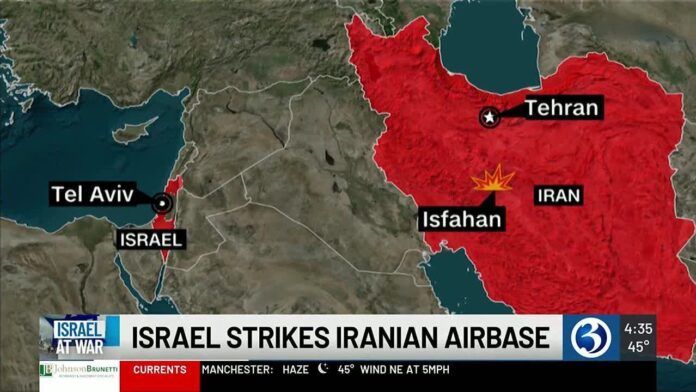Amid heightened tensions, Israel carries out a calculated strike on an Iranian airbase, signalling a restrained yet strategic response to recent provocations
In the early hours of Friday, Israel strikes a calculated missile attack targeting an airbase outside the Iranian city of Isfahan. This operation follows a series of threats and minor skirmishes that have heightened tensions between the two nations. Israel’s decision to carry out a precise and limited strike rather than a broad military campaign signals a strategic approach to the conflict, aiming to mitigate escalation while demonstrating its readiness to respond to threats. The targeted airbase, associated with Iran’s aircraft manufacturing, has been linked to the recent drone attacks on Israel, thereby making it a symbolic and strategic point of focus in this latest altercation. This incident marks a critical juncture in the Israel-Iran standoff, shedding light on the tactical considerations that are shaping the military strategies of both nations in this prolonged conflict.
Sky News
Sky News provides a detailed analysis of the recent Israeli strike on an Iranian airbase near Isfahan. According to their report, Israel opted for a strategic, non-devastating strike aimed at specific military installations associated with Iran’s aircraft manufacturing capabilities. This choice of target seems directly linked to the recent drone attacks Iran launched against Israel. The timing of the strike, at approximately 4 AM, suggests a tactical move to minimize human casualties and potential Iranian retaliation. Sky News emphasizes that this move by Israel is not just about immediate retaliation but also a demonstration of strategic restraint, highlighting Israel’s capability to strike critical infrastructure without escalating to a full-blown conflict. Furthermore, the coverage also touches upon additional sounds of explosions in the region, which might be related to Israeli jets breaking the sound barrier, rather than direct attacks, indicating the high state of alert in the region.
The Guardian
The Guardian’s coverage of the Israeli strike focuses on the geopolitical implications and the careful calibration behind Israel’s military actions. According to their report, U.S. officials were briefed by Israel prior to the operation, which underscores the level of strategic planning and international diplomatic considerations involved. The Guardian points out that while the airbase targeted is close to some of Iran’s nuclear facilities, these were not the focus of the strike, suggesting Israel’s intent to avoid a major escalation that could draw broader regional or global powers into a more intense conflict. The article also discusses the Iranian response, which has been notably restrained, with officials downplaying the extent of the damage and maintaining that all key military and nuclear sites remain secure. This narrative suggests a potential desire on both sides to manage the situation carefully, avoiding actions that could trigger a more severe military exchange.
The Independent
The Independent offers insights into the local responses and immediate consequences of the Israeli strike within Iran. Their report discusses the activation of Iran’s air defence systems and the temporary closure of airspace over key regions, which disrupted civil aviation and signalled a high-alert status across the Iranian military and security apparatus. The coverage details how these defensive measures were prompted by unconfirmed reports of explosions near the targeted airbase, which could have been due to either the strike itself or defensive reactions to perceived threats. This article also examines the broader context of increasing military tensions between Israel and Iran, suggesting that while both nations are prepared for conflict, there is also an evident caution in their actions to prevent a rapid escalation that could be difficult to control. Additionally, the Independent sheds light on international reactions, noting adjustments in global aviation routes and potential shifts in regional military postures in response to the strike.
The Telegraph
The Telegraph delves into the strategic underpinnings and potential consequences of Israel’s decision to target the Isfahan airbase. Their analysis suggests that the strike was not only a response to specific provocations but also a broader message to Iran and international observers about Israel’s military capabilities and strategic reach. The article explores the implications of such a strike on the possibility of future conflicts in the region, discussing how Israel’s actions could set new precedents for military engagements between Israel and Iran. It also considers the international dimension, including potential reactions from the United States and European Union, which have historically played pivotal roles in mediating conflicts in the Middle East. The Telegraph posits that this incident might lead to new diplomatic alignments or initiatives aimed at preventing further deterioration of regional security.
Financial Times
The Financial Times focuses on the economic and strategic ramifications of the Israeli airstrike. The coverage highlights the immediate impact on global oil markets, with prices rising sharply in response to the increased geopolitical risks in a region that is pivotal to global energy supplies. The article analyzes how such military actions can have far-reaching effects beyond the immediate tactical outcomes, influencing global economic conditions and potentially altering the strategies of major energy-consuming nations. The Financial Times also discusses the broader strategic context, noting the careful calibration of the strike to avoid escalating tensions while still sending a strong message of deterrence. This perspective provides a comprehensive view of how military actions are interlinked with global economic stability and strategic international relations.
